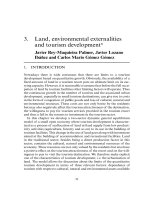THE ECONOMICS OF MONEY,BANKING, AND FINANCIAL MARKETS 473
Bạn đang xem bản rút gọn của tài liệu. Xem và tải ngay bản đầy đủ của tài liệu tại đây (75.78 KB, 1 trang )
CHAPTER 17
441
Tools of Monetary Policy
Dollar
goes
down
te
Ra
of
fla
In
tio
n
Prices
Decrease in
target for the
overnight
interest rate
Increase
in
demand
$
Costs
Interest
rates
go down
F I G U R E 17- 4
How the Bank of Canada Keeps the Rate of Inflation from Falling
Below the Target Range
Source: Bank of Canada website: www.bankofcanada.ca. Reprinted with permission.
Hence, by changing the target and operating band for the overnight rate, the
Bank of Canada sends a signal regarding the direction that it would like interest
rates and the money supply to take. A rise in the target and operating band, and
thus the bank rate, is a signal that the Bank would like to see higher interest rates
and less money in the economy. A fall in the target and operating band is a signal
that the Bank would like lower interest rates and more money.
Nominal
Interest
Rates and
Monetary
Policy
The Bank of Canada uses the nominal overnight interest rate as its operating
instrument, but as you will learn in Chapter 25, the effects of monetary policy on
economic activity stem from how the real interest rate, ir, rather than the nominal
interest rate, i, affects consumption and investment spending. In fact, the current
interest rate targeting approach is based on the belief that it is the real long-term
interest rate, and not the real short-term interest rate, that affects consumer and
business decisions.
How is it that changes in short-term nominal interest rates (such as the Bank of
Canada s overnight rate) affect short- and long-term real interest rates? Under the
new Keynesian assumption of sticky prices (that is, under the assumption that
prices do not adjust instantaneously to clear the markets), an expansionary monetary policy that lowers the short-term nominal interest rate will also lower the shortterm real interest rate, since the aggregate price level adjusts slowly over time and
there is not much change in the inflation rate. Moreover, according to the expectations hypothesis of the term structure of interest rates (discussed in detail in Chapter
6), the decline in short-term interest rates will also lead to a decline in long-term
interest rates and ultimately to increases in consumer and investment spending.









